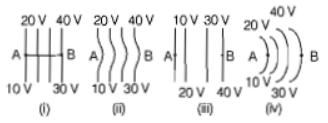If identical charges (–q) are placed at each corner of a cube of side b, then electric potential energy of charge (+q) which is placed at centre of the cube will be -
(1)
(2)
(3)
(4)
Equipotential surfaces associated with an electric field which is increasing in magnitude along the x-direction are
(1) Planes parallel to yz-plane
(2) Planes parallel to xy-plane
(3) Planes parallel to xz-plane
(4) Coaxial cylinders of increasing radii around the x-axis
A parallel plate condenser has a capacitance \(50~\mu\text{F}\) in air and \(110~\mu\text{F}\) when immersed in an oil. The dielectric constant \(k\) of the oil is:
1. \(0.45\)
2. \(0.55\)
3. \(1.10\)
4. \(2.20\)
Separation between the plates of a parallel plate capacitor is d and the area of each plate is A. When a slab of material of dielectric constant k and thickness t(t < d) is introduced between the plates, its capacitance becomes -
(1)
(2)
(3)
(4)
The capacity and the energy stored in a parallel plate condenser with air between its plates are respectively CO and WO. If the air is replaced by glass (dielectric constant = 5) between the plates, the capacity of the plates and the energy stored in it will respectively be -
(1)
(2)
(3)
(4)
A 6 μF capacitor is charged from 10 volts to 20 volts. Increase in energy will be
1. 18 × 10–4 J
2. 9 × 10–4 J
3. 4.5 × 10–4 J
4. 9 × 10–6 J
Three capacitors are connected to D.C. source of 100 volts shown in the adjoining figure. If the charge accumulated on plates of C1, C2 and C3 are and qf respectively, then
(1)
(2)
(3)
(4)
Five capacitors of 10 μF capacity each are connected to a d.c. potential of 100 volts as shown in the adjoining figure. The equivalent capacitance between the points A and B will be equal to
(1) 40 μF
(2) 20 μF
(3) 30 μF
(4) 10 μF
A capacitor is charged by a battery. The battery is removed and another identical uncharged capacitor is connected in parallel. The total electrostatic energy of the resulting system
1. increases by a factor of 4
2.decreases by a factor of 2
3. remain the same
4. increases by a factor of 2
The diagrams below show regions of equipotentials.
A positive charge is moved from A to B in each diagram.
(1) Maximum work is requried to move q in figure(iii)
(2) In all the four cases,the work done is the same
(3) Minimum work is requried to move q in the figure(i)
(4) Maximum work is required to move q in figure(ii)









